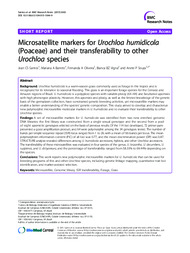Microsatellite markers for Urochloa humidicola (Poaceae) and their transferability to other Urochloa species.
Microsatellite markers for Urochloa humidicola (Poaceae) and their transferability to other Urochloa species.
Author(s): SANTOS, J. C. S.; BARRETO, M. A.; OLIVEIRA, F. A.; VIGNA, B. B. Z.; SOUZA, A. P.
Summary: Urochloa humidicola is a warm-season grass commonly used as forage in the tropics and is recognized for its tolerance to seasonal flooding. This grass is an important forage species for the Cerrado and Amazon regions of Brazil. U. humidicola is a polyploid species with variable ploidy (6X-9X) and facultative apomixis with high phenotypic plasticity. However, this apomixis and ploidy, as well as the limited knowledge of the genetic basis of the germplasm collection, have constrained genetic breeding activities, yet microsatellite markers may enable a better understanding of the species' genetic composition. This study aimed to develop and characterize new polymorphic microsatellite molecular markers in U. humidicola and to evaluate their transferability to other Urochloa species.
Publication year: 2015
Types of publication: Journal article
Keywords: Genomic library, Grass, Microsatellite, SSR transferability, forage
Observation
Some of Embrapa's publications are published as ePub files. To read them, use or download one of the following free software options to your computer or mobile device. Android: Google Play Books; IOS: iBooks; Windows and Linux: Calibre.
Access other publications
Access the Agricultural Research Database (BDPA) to consult Embrapa's full library collection and records.
Visit Embrapa Bookstore to purchase books and other publications sold by Embrapa.

